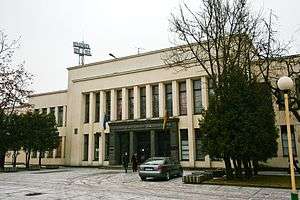Basketball in Lithuania
Basketball is the most popular sport in Lithuania. Lithuanian American basketball coaches and players in the 1930s helped the Lithuania men's national basketball team win the last EuroBasket tournaments prior to World War II, in 1937 and 1939, causing a massive impact in Lithuanian society and a basketball popularity spike. Since then, despite Lithuania's small size, with a population of just almost 2.9 million, the country's devotion to basketball has made them a traditional force of the sport in Europe.[1]
| Basketball in Lithuania | |
|---|---|
| Country | Lithuania |
| Governing body | Lithuanian Basketball Federation |
| National team(s) | Lithuania men's national basketball team Lithuania women's national basketball team |
| First played | 1919 |
| Clubs | 162 (Men)[1] |
National competitions | |
Club competitions | |
Lietuvos krepšinio lyga Nacionalinė krepšinio lyga Regioninė krepšinio lyga Lithuanian Women's Basketball League | |
International competitions | |
Following the country's annexation by the Soviet Union during the war, Lithuanian players frequently formed the core of the Soviet national team, and the Lithuanian people strongly supported local club BC Žalgiris, particularly against Russian squads. After the restoration of Lithuanian independence in 1990, the national team was resurrected, with their first official tournament being the 1992 Olympics, where they won a bronze medal. The Lithuanians have since won another two bronzes at the Olympics, a bronze medal at the 2010 FIBA World Championship, and five EuroBasket medals, including the country's third title at FIBA EuroBasket 2003 in Sweden.
At the professional club level, Žalgiris of Kaunas won the top-tier EuroLeague in 1999 and the second-tier FIBA Saporta Cup in 2000, and was also the FIBA Intercontinental Cup champion in 1986 under Soviet occupation. BC Lietuvos rytas of Vilnius won two times the second tier EuroCup, in 2005 and 2009.
While basketball started being played in Lithuania by women, the women's national team has not achieved the same success as the male one, despite a title at EuroBasket Women 1997.
History
Interwar period (1920–1940)
Basketball was introduced in Lithuania indirectly through the European variety of Netball, featuring a smaller ball and no boards, brought by the Germans. In 1919 Lithuanian women athletes started organizing, and in 1920-1921 they started playing the game in public.[2] The female pioneerism delayed basketball's widespread popularity until the 1930s as it kept being considered a woman's sport.[3][4] In the meantime, in 1922 Karolis Dineika released the book Krepšiasvydis vyrams (English: Basketball for men), and in 1926 pilot Steponas Darius, who would later be known for his transatlantic flight, published the first basketball rules in Lithuania.[5][6]
Despite the fact that women were the first basketball players in Lithuania, the first official game was played by men. It took place on 23 April 1922 when Lietuvos Fizinio Lavinimo Sąjunga (English: Lithuanian Physical Education Union) played a game against Kaunas team, winning 8–6. That day is regarded as the beginning of basketball in Lithuania. The press at the time described the match by writing: "The game was very interesting and left positive impression on the spectators. The observers were fascinated by the game so much that they felt living in a quite cultured country by watching our quick, joyful players. <...> The audience heartily rejoiced at the gameplay of the excellent basketball players and applauded after shots and passes by Steponas Darius and Viktoras Dineika. <...> Krepšiasvydis game, organized for the first time in Lithuania, gave beautiful hopes that in the future this game could lead our sportsmen to greater achievements".[7] Two years later, the first Lithuanian men's basketball tournament in Lithuania was organized, featuring two teams from LFLS and one from Lietuvos Dviračių Sąjunga (English: Lithuanian Cycles Union), and a course for basketball referees was held. The first class included Elena Garbačiauskienė and Steponas Darius.[8]
From 1926 to 1933, basketball saw its popularity decrease and get overshadowed by football. Basketball was played only during the summer period because there was no suitable indoor arena, and the game was mostly played by representatives of other sports, who allocated little time to it. The number of games played decreased, and the national championship was not even contested between 1929 and 1932.[9] It started to change on 10 October 1934, the day where the Physical Culture Palace was opened in Kaunas. The building had a spacious hall with 200 seats, designed and built for tennis. To increase grip for tennis players, the hall had expensive cork floor installed, which cost over 30,000 LTL (over $5,000) when average teacher salary at the time was around 350-500 LTL and 150-180 LTL for an ordinary worker.[10] Being suitable for indoor basketball, the Hall hosted its first game on 16 November 1934, and soon became the main center for basketball events.[11]
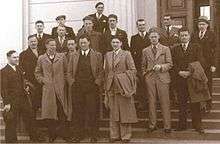
In 1935, Lithuania decided to promote a World Lithuanian Congress in temporary capital Kaunas, inviting ethnic Lithuanians from many countries to unite the Lithuanian culture. The Lithuanian American community of Chicago decided to sponsor a team of athletes to participate in this Congress. The delegation included a full basketball team, which included University of Notre Dame star Moose Krause (Edward Kriaučiūnas) and his brother Phil (Feliksas Kriaučiūnas); basketballers Benedict Budrikas, Anthony Lauraitis, Victor Yanzanaitis and Julius Petrulaitis; and multi-sport athletes Konstantinas "Konnie" Savickus, Juozas "Joseph" Zukas, Peter Barskis, Michael A. Lukas, and Kazys "Charles" Sedvilas.[12] After the three-week congress, Zukas and Savickus stayed to teach basketball secrets to Lithuanians.[13] Savickus in particular became a player-coach to the national team, which had just been trounced by inaugural European champions Latvia 123-10. One year later, with Savickus leading the team and exploiting stalling techniques, Lithuania trailed only 14-7 at halftime before losing 31-10. The Lithuanian press declared it a moral victory.[14]
Also in 1936, Lithuania applied to become a member of FIBA and take part in international basketball competitions,[15] the first being EuroBasket 1937, the second European basketball tournament that the Latvia Basketball Association would organize in Riga as reigning champions.[16] Thus while basketball would become an Olympic sport at the 1936 Summer Olympics in Berlin, Lithuania decided not to take part in the tournament, instead preparing for the following year.[14] During the Olympics, one of the gold medalists, Frank Lubin, was of Lithuanian heritage, and was invited to visit the Baltic nation by a Lithuanian official in attendance. Going by the Lithuanian name Pranas Lubinas, he spent five months there and served as the country's first knowledgeable coach, helping spread various basketball techniques.[17][18] Filling in for Savickus, who had returned to Chicago, Lubinas led Lithuania to its first victory over Latvia, 36-25.[13]
— Konstantinas Savickas, describing his first efforts to improve basketball in Lithuania.[19]
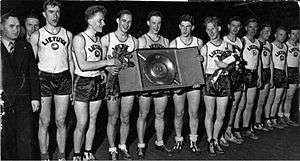
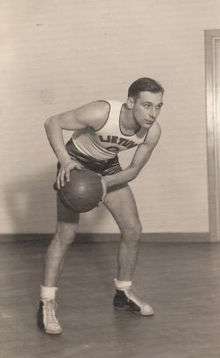
The preparations for the EuroBasket 1937 started slowly, with players training only 4 hours a week. At first, it was decided that the national team at the tournament would not include any Lithuanian Americans; however the decision was reversed with only one month remaining, once a Latvian newspaper had printed an extensive article about the second European championship considering Lithuania the weakest of all contestants. Lithuanian player Leonas Baltrūnas was shocked at the article and along with journalist Jonas Narbutas, used a translated version of it to request the inclusion of Lithuanian Americans to Vytautas Augustauskas, director of the Physical Culture Palace. After a telegram was sent to the USA, two players arrived one month prior to the tournament, Pranas Talzūnas and Feliksas Kriaučiūnas, the latter of whom was designated as player-coach. To keep secrecy on how Lithuanian Americans were strengthening the team, all preparation games were cancelled and instead prolonged training sessions before the trip to Riga were held behind closed doors. The national team was being prepared not only technically, but also physically. Even once the reinforcements were made public, opponents were skeptic, with Talzūnas later remembering other teams felt he and Kriaučiūnas were not quality players as "everyone thought that a good player must be tall, raising his hand and dunking into the basket.".[20]
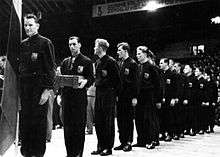
The efforts were successful - the Lithuanians became the champions of Europe for the first time, defeating all their opponents and with Talzūnas being picked as the tournament's most valuable player. Following the final victory over Italy, the famous Lithuanian tenor Kipras Petrauskas even interrupted his performance at the State Theatre to joyfully announce the triumph of the national basketball team. The crowd then rose to their feet and together sang the Lithuanian anthem.[21] The team returned to a warm reception, with thousands gathering at a train station in a way Kriaučiūnas compared to "like we, here in America, greet the president."[22] Basketball regained its ground immediately, and had its popularity rise abruptly, especially among students. Gymnasium teams from almost all counties competed in student games, teams were assembled in firms and basketball courts appeared all around the country. According to future player Stepas Butautas, "In every yard hoops are being made from barrels. Children, teenagers are throwing balls into them, others - even a sock crammed with clouts. Our Veršvai Primary School teacher K. Požemecka built two poles, made hoops from a willow and said: 'We will play basketball'."[23] Future team coach Vladas Garastas added that "as kids we started using a barrel to make a hoop. We didn't have a ball, we stuffed in grass or whatever we could find".[24] Kriaučiūnas also coached the women's national team that did well at the first European women's basketball championship, organized in 1938 in Rome. With three victories in four games, the Lithuanian women finished second behind hosts Italy.[25]
Lithuania was granted the right to organize the EuroBasket 1939. In addition, the Kaunas Sports Hall, Europe's first dedicated basketball arena, was built. In the competition, the team roster mostly consisted of Lithuanian Americans, with five American-born players: the returning Feliksas Kriaučiūnas (Chicago), Juozas Jurgėla (Chicago), Vytautas Budriūnas (Waukegan), Mykolas Ruzgys and Pranas Lubinas (Glendale). As a result, there were several protests from other nations.[26] Lubinas, who was the designated player-coach, lead Lithuania to a second continental title, even scoring the buzzer-beater in the decisive game against Latvia, which warranted a 37–36 victory.[27]
Team dissolution during World War II
.jpg)
After two consecutive EuroBasket titles, Pranas Lubinas dreamed of leading Lithuania at the 1940 Summer Olympics. Sadly, it remained only a dream as the World War II broke out one year before and the Olympics were cancelled.[27] With Nazi Germany invading Europe and the Soviet Union occupying the Baltic states in 1940, the Lithuanian basketball players and basketball-supporting president Antanas Smetona left for safer countries such as the United States and Australia. Only a few of them had a chance to return to Lithuania in 1989-1990.[28] As a consequence, none of the European champions played for the Soviet Union after the war ended. The EuroBasket 1941 was due to take place in Lithuania as well, but was cancelled due to the war.[29] Instead, Lithuania only hosted a Baltic states tournament organized at Kaunas Sports Hall in April 1941, beating Latvia 38–33 in front of 6000 spectators.[15] Two months later, mass Soviet deportations from Lithuania began. Juozas Butrimas, Siberia deportations survivor, once said: "Our whole sports club was falsely accused of participating in an anti-Soviet Lithuanian resistance organization. In Siberia, we built a regulation basketball court. Basketball allowed us to have dignity, to retain our sense of humanity. How did I survived? Basketball gave a lot. They didn't bury me there".[30]
During the rest of the war, with the Germans occupying Lithuania in November 1941 and the Soviets taking it back three years later, all the basketballers who did not escape the country went through difficult times. Vincas Sercevičius, often nicknamed as the second Lubinas, had to run away from German raids in 1943. Two years later, Sercevičius was a member of the Žalgiris Kaunas who refused to purposefully lose to CSKA Moscow, leading him and other teammates, along with coach Stasys Šačkus, to end up shipped to the Vorkuta Gulag by the Soviets.[31][32][33]
Soviet period (1947–1990)
— Mykolas Ruzgys, describing the Soviet squad in a 1968 interview.[34]
The first Soviet Union national basketball team was formed in 1947 to participate in EuroBasket 1947, immediately winning gold medals. The team had four Lithuanians: Stepas Butautas, Justinas Lagunavičius, Kazimieras Petkevičius and Vytautas Kulakauskas.[35]
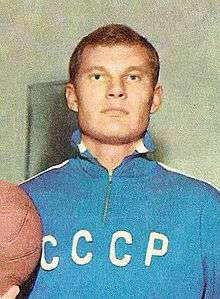
Given the Soviet Union was absent from the 1948 Summer Olympics, Lithuanian basketballers could only fulfill their dreams of playing on the Olympic stage at the 1952 Olympic Games, where they qualified by winning EuroBasket 1951. The Soviets got a silver medal, losing only two games against the United States, who had a height advantage - the shortest of their players was still taller than the highest Soviet - and would soon become the USSR's biggest rival.[36][37] The team was led by Georgian player Otar Korkia (17.3 points per game), along with Lithuanians Stepas Butautas (10.6 points) and Kazimieras Petkevičius (8.1 points). Two other Lithuanians, Justinas Lagunavičius and Stanislovas Stonkus, were also in the team.[38] The four are regarded as the first Lithuania-born Olympic basketball players.[39] Years later, Modestas Paulauskas served as the Soviet Union captain starting in 1969, and would lead the USSR to an historic upset of the United States at the 1972 Olympic Games, making them the first Olympic champions other than the Americans.[14][40]
According to journalist and future LKL employee Arūnas Pakula, "We felt like an occupied nation. We had no weapons to use. The only opportunity to prove ourselves against the Soviets was in basketball."[41] Despite not being able to challenge the Soviet Union on basketball court, Lithuanians still did that in another way. Basketball club Žalgiris Kaunas, established in 1944 (just a few years after the country's occupation) with a name commemorating the Battle of Grunwald, became one of the main non-violent resistance ways. Games between Žalgiris and CSKA Moscow, a military basketball team mostly formed from best Soviet Union basketball players, were de facto games between Lithuania and the Soviet Union, and led to mass rallies of sorts once Lithuanians went to receive Žalgiris' players at airports after victories. The teams from Baltic states even tried to help each other during the Soviet tournaments, most notably in 1973. During the last round, the already qualified Žalgiris Kaunas deliberately lost to Kalev Tallinn, as admitted by Paulauskas: "We gave victory to Tallinn Kalev. That game meant nothing for us, while for Estonians it was crucial in order to avoid the fight for the survival in the highest league".[42] During the Stagnation and subsequent dissolution of the Soviet Union, the success of Lithuanian basketball provided many moments to showcase their nationalism against the Soviet dominance. The 1981 students sport games in Vilnius had the locals attending in the Lithuanian green and yellow colors to see the national youth team led by Arvydas Sabonis and Šarūnas Marčiulionis defeat the Moscow squad.[42] In the 1980s, Žalgiris defeated CSKA three times in a row for the USSR Premier Basketball League finals (1985-1987). One of their players, Sergėjus Jovaiša, stated that in 1987 CSKA was even preparing a huge celebration with orchestra and flowers before the defeat.[42] Žalgiris also won the 1986 Intercontinental Cup in Argentina, receiving much support from the home crowd against the Yugoslavs of Zagreb Cibona. Their return to Europe attracted a huge crowd, with Žalgiris captain Valdemaras Chomičius stating that in Aleksotas Airport "it seemed that the whole Kaunas gathered that early morning."[42]
— Pranas Lubinas, sharing his memories related to basketball in Lithuania, in a 1989 interview.[43]
In 1988, Atlanta Hawks which included its major star Dominique Wilkins became the first NBA club to visit Lithuania and played friendly game with the Soviet Union national team in the Vilnius Palace of Concerts and Sports.[44][45] Later, the Soviet Union squad became Olympic champions in the 1988 Summer Olympics for the second and the last time, defeating the United States 82–76 in the semi-finals and Yugoslavia 76–63 in the finals. The team mostly was led by four Lithuanians: Šarūnas Marčiulionis (18.1 points, 2.3 assists per game), Rimas Kurtinaitis (13.4 points, 3 rebounds), Arvydas Sabonis (13.3 points, 11.1 rebounds) and team captain Valdemaras Chomičius (7.4 points, 1.5 rebounds).[46] Vytautas Landsbergis, the first head of state of Lithuania after its independence declaration from the Soviet Union, once said: "The majority of the team was made up of Lithuanians. So really Lithuania won that gold medal for the Soviet Union. But its name wasn't there. And that was another injustice that we had to correct".[47]
Once Lithuania became the first Union Republic to declare independence on 11 March 1990, the Soviet Union national team did not even qualify for the EuroBasket 1991.[48] During the 43 years where the Soviets had Lithuanian players, they managed to get with both male and female squads 17 Olympic medals (8 gold, 6 silver and 3 bronze), 17 World championship medals (11 gold, 5 silver and one bronze), and 51 EuroBasket medals (36 gold, 4 silver and 11 bronze).[49] The occupation left many painful marks in Lithuania and Lithuanians' memory. Games between Žalgiris and CSKA, as well as games between Lithuania and Russian national teams, still have extra spice in them nowadays. Singing of the Lithuanian anthem before the professional club's games in Lithuania is still a rare tradition, rarely found outside the National Basketball Association in Europe.
Notable players (men)
Notable Lithuania national basketball team members
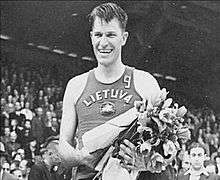
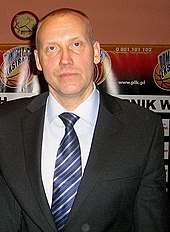
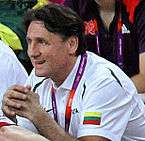

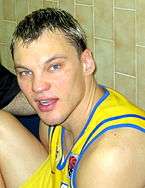
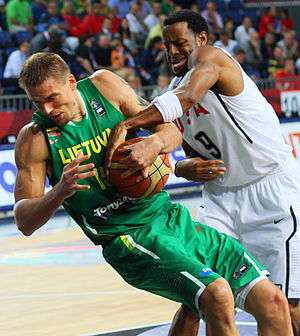
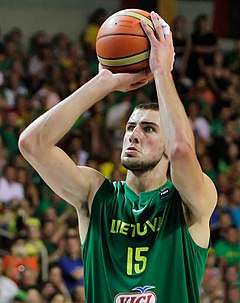
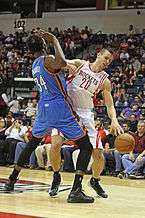
| Name | Position | Years | PPG | RPG | APG | Remarks |
|---|---|---|---|---|---|---|
| Feliksas Kriaučiūnas | 1937, 1939 | 3.4‡ | N/A | N/A | Notable for his efforts in coaching and popularizing basketball in Lithuania during the late 1930s. He also firmly contributed in developing nowadays basketball in Lithuania. | |
| Pranas Talzūnas | 1937 | 12.2‡ | N/A | N/A | Led the team during EuroBasket 1937 and was named MVP of the tournament. Talzūnas is regarded as the first player to use hook shot. | |
| Leonas Baltrūnas | 1937, 1939 | 4.5‡ | N/A | N/A | Not very famous for his contributions during the European championships in points, but is very remarkable in the Lithuanian sport and especially the Lithuanian Australian sport history. He has firmly contributing in popularizing the sport there, being the organizer of the first Lithuanian Australian Sport Games in 1950. The games are still ongoing nowadays. He also was the Australian national team coach in 1955. | |
| Pranas Lubinas | Center | 1939 | 13.17‡ | N/A | N/A | Popularized the sport in Lithuania in the late 1930s. He was de facto MVP of EuroBasket 1939 (not officially awarded due to him being too tall). As a result, Lubinas is often regarded as the "grandfather of Lithuanian basketball". Before playing for Lithuania squad, Pranas Lubinas won the gold medal at the inaugural basketball Olympic tournament in 1936 as Team USA captain. |
| Mykolas Ruzgys | 1939 | 10.2‡ | N/A | N/A | The official EuroBasket 1939 MVP. Pranas Lubinas was unable to receive the award due to his height. Later he coached the Spanish National Team during the 1950 FIBA World Championship in Argentina. | |
| Vytautas Budriūnas | 1939 | 10.4‡ | N/A | N/A | One of the hook shot pioneers, also notable for his one-handed jump shot. | |
| Juozas Jurgėla | 1939 | 4.2‡ | N/A | N/A | One of the key players in EuroBasket 1939. Noted for impressive dribbling and passing. | |
| Sergėjus Jovaiša | Small forward | 1992 | 3.1‡ | 0.3 | 0.3 | Jovaiša won most of his titles with the Soviet Union, but he also was member of the first post-independence Lithuania national basketball team, winning a bronze at the 1992 Olympics. |
| Arvydas Sabonis | Center | 1992, 1995–1996, 1999 | 20.00 | 11.4 | 2.2 | One of the best known Lithuanian basketball players, helped Lithuania win two Olympic bronze medals in 1992 and 1996, plus a European silver in 1995. He was a large contributor to the successful Portland Trail Blazers teams from 1995–2003. He was inducted into the FIBA and Naismith Hall of Fame. His son Domantas now plays for the Oklahoma City Thunder in the NBA, and was picked for the Lithuanian squad multiple times. Arvydas and Domantas Sabonis are the first father-son duo in the national team's history. |
| Šarūnas Marčiulionis | Point guard Shooting guard | 1992, 1995–1996 | 20.15 | 4.1 | 6.4 | One of the key players in the 1992 and 1996 Olympics and 1995 EuroBasket, being named tournament MVP of the latter. He helped resurrect the Lithuania national team before the 1992 Barcelona Olympics. Marčiulionis is the first NBA player in Lithuania history and is also famous for bringing Euro step move to the NBA. In 2014, he was inducted into the Basketball Hall of Fame. |
| Rimas Kurtinaitis | Small forward Shooting guard | 1992, 1995–1996 | 13.40 | 2.6 | 1.9 | Outstanding three-point shooter. He is the only non-NBA player who participated in the NBA All-Star Three-Point Contest. |
| Valdemaras Chomičius | Point guard | 1992, 1995 | 10.30 | 1.2 | 1.6 | Won most of his titles with the Soviet Union, but was part of the 1992 Olympics and 1995 EuroBasket Lithuanian teams before retirement. |
| Gintaras Einikis | Center | 1992, 1995–2001 | 9.7 | Famous for his trademark hook shot, Einikis is the all-time most capped Lithuanian (106 games), as well as the only player in all three Olympic bronze medals (1992, 1996, 2000). Gintaras also participated in four EuroBaskets, winning silver in 1995 and 2001. | ||
| Artūras Karnišovas | Small forward Power forward | 1992, 1995–1999 | 18.20 | 5.1 | 2.4 | Lithuania's all-time leader in points (total 1453 points), won two Olympic bronzes (1992, 1996) and the EuroBasket silver in 1995. He averaged 18.2 points per game in all of his tournaments combined. On 15 June 2017, he became general manager of the Denver Nuggets and is the first Lithuanian in such position.[50] |
| Saulius Štombergas | Small forward Power forward | 1995–2001, 2003–2004 | 10.9 | 3.2 | 1.5 | One of the best three-point shooters in Lithuania basketball history. He also was team captain during the EuroBasket 2003 title. |
| Mindaugas Žukauskas | Small forward Power forward | 1996, 1998–1999, 2001, 2003–2006 | 5.3 | 2.3 | 1.3 | A long time Lithuania national basketball team captain, known for his aggressive defense. |
| Eurelijus Žukauskas | Center | 1996–2001, 2003–2004 | 5.9 | 4.0 | 0.5 | Outstanding defender and shot blocker. Won a gold medal for Lithuania at EuroBasket 2003, and was also part of the Žalgiris team that won the 1999 Euroleague. |
| Šarūnas Jasikevičius | Point guard | 1997–2001, 2003–2004, 2007–2008, 2011–2012 | 10.0 | 2.3 | 4.9 | One of the most famous Lithuania players in the history. He led Lithuania to its third gold medal in EuroBasket 2003, being named MVP of that tournament. He also won a bronze medal at the 2000 Olympics, and led Lithuania in a notable win against Team USA in 2004 Summer Olympics, scoring 28 points (7/12 three-pointers). In 2015, Jasikevičius was named as one of the EuroLeague legends. |
| Rimantas Kaukėnas | Shooting guard | 2001, 2007–2008, 2011–2012 | 9.5 | 2 | 1.6 | Notable for his scoring ability. One of the key players in EuroBasket 2007. Kaukėnas number 13 was retired by Montepaschi Siena in 2009. |
| Ramūnas Šiškauskas | Point guard Shooting guard Small forward | 2000–2001, 2003–2005, 2007–2008 | 12.9 | 3.2 | 2.1 | A long time Lithuania national basketball team captain, nicknamed "Baltic Pippen" for his outstanding efficiency on court. In 2014, Šiškauskas was named as one of the EuroLeague legends. |
| Darius Songaila | Power forward Center | 2000-2001, 2003–2004, 2006–2007, 2011–2012 | 9.0 | 3.7 | 0.8 | Long time NBA and Lithuania national team player. One of the key players in EuroBasket 2003. |
| Arvydas Macijauskas | Shooting guard | 2003–2004, 2006 | 15.1 | 2.7 | 1.5 | Outstanding three-point shooter, earning the nickname "Kalashnikov", and one of the key players in EuroBasket 2003. |
| Kšyštof Lavrinovič | Power forward Center | 2003–2009, 2011, 2013–2014 | 7.1 | 4.2 | 0.8 | An all-around power forward noted for his efficiency on court. He and his twin brother Darjuš are the first Poles to represent Lithuania national team. |
| Darjuš Lavrinovič | Center | 2005–2009, 2013–2014 | 7.8 | 3.4 | 0.9 | An all-around versatile center. |
| Robertas Javtokas | Center | 2001, 2004–2011, 2013, 2015–2016 | 5.2 | 4 | 0.5 | A long time Lithuania national basketball team captain notable for his efficient defense and devotion to the team, not quitting games despite pain and various injuries. Javtokas is also famous for a world dunking record, dunking into a 3.65 m high basket in 2001. |
| Linas Kleiza | Power forward | 2006–2010, 2012–2013 | 13.0 | 5.6 | 1.1 | Led the team in the 2010 World Championship and the 2012 Olympics. Kleiza is also the Lithuanian who scored the most points in an NBA game, with 41 in 2008.[51] In 2013, Kleiza signed with Fenerbahçe Ülker and became the most expensive player in Turkish Basketball Super League history,[52] as well as the best paid basketball player in that season's EuroLeague.[53] |
| Mantas Kalnietis | Point guard Shooting guard | 2006, 2009–2013, 2015–2016 | 9.1 | 2.8 | 4.5 | Led the team in EuroBasket 2013, and was tournament leader in assists for both that edition (5 per game), and the follow-up in 2015 (7.8 assists per game). |
| Jonas Mačiulis | Small forward | 2007, 2008–2010, 2012–2016 | 7.7 | 3.5 | 1.1 | Led the team during the critical moments in EuroBasket 2015 and was included into the All-Tournament Team. |
| Jonas Valančiūnas | Center | 2011–2016 | 9.6 | 5.7 | 0.4 | The first major star born in post-Soviet Lithuania. Before making his debut with the senior national team at 19, he led Lithuania youth basketball teams to three gold medals and was named MVP of all three tournaments. He's also the Lithuanian picked the highest on the NBA Draft, being fifth overall at the 2011 NBA Draft. The same year he debuted in Lithuania men's national team, being a key players in EuroBasket 2011. On 20 August 2015, Valančiūnas signed a record four-year $64 million deal with the Toronto Raptors and became the all-time best paid Lithuanian in history.[54] |
| Donatas Motiejūnas | Power forward Center | 2013–2014 | 6.1 | 3.1 | 0.4 | One of the highest ever NBA drafted Lithuanians, picked 20th overall in 2011 by the Minnesota Timberwolves. Before making debut in senior national team, Motiejūnas led Lithuania youth basketball teams to two silver medals and was named MVP of U-18 championship. Motiejūnas is notable for his versatility, agility and terrific post-game. Often nicknamed as "Captain hook". |
| Mindaugas Kuzminskas | Small forward | 2013–2016 | ? | ? | ? | Former NBA player. In 2016, he signed with the New York Knicks. |
| Domantas Sabonis | Power forward Center | 2015–2016 | 3.0 | 2.0 | 0.0 | Son of the Lithuanian legend Arvydas Sabonis. Domantas is the all-time youngest Lithuanian to debut in a game representing the primary men's national team. He is also second highest drafted Lithuanian in history, picked 11th overall in 2016 by the Orlando Magic. On 21 January 2020, Sabonis became the first Lithuanian in NBA history to record a triple-double.[55] On 30 January 2020, Sabonis was chosen to the 2020 NBA All-Star Game and became only the second Lithuanian to be chosen as a NBA All-Star.[56] |
Notable Lithuanians who never played for Lithuania national basketball team
There have been a few notable Lithuanians who never played for Lithuania national basketball team in FIBA-organized tournaments or the Olympic Games. Most of those lived in the Lithuanian Soviet Socialist Republic, who only competed independently in tournaments between the United Republics.
| Name | Professional career | Reason | Remarks |
|---|---|---|---|
| Vytautas Kulakauskas | 1944–1949 | Soviet Union occupation | EuroBasket 1947 champion with the Soviet Union. |
| Stepas Butautas | 1944–1956 | Soviet Union occupation | Legendary Žalgiris and Lithuania player, coach. As part of the Soviet Union, won an Olympic silver medal in 1952 and three EuroBaskets in 1947, 1951, and 1953. He was named as one of FIBA's 50 Greatest Players. |
| Vincas Sercevičius | 1944–1951 | Nazi Germany, Soviet Union occupations | Legendary Žalgiris player, two times USSR tournament champion. He was a peerless center, outstanding hook shots specialist with his both hands. Often nicknamed "second Lubinas". Survived the Nazi occupation, and after the war, wound up blacklisted by the Soviet government for rebellious activities and thus vetoed for possible inclusion in the Soviet Union national team.[57] |
| Justinas Lagunavičius | 1944–1957 | Soviet Union occupation | As part of the Soviet Union, won an Olympic silver medal in 1952 and three EuroBaskets in 1947, 1951, and 1953. |
| Kazimieras Petkevičius | 1945–1962 | Soviet Union occupation | Legendary Žalgiris and Lithuania player, coach. Won Olympic silver medals twice in 1952 and 1956, was European champion in 1947, and won a EuroBasket bronze in 1955. |
| Algirdas Lauritėnas | 1950–1963 | Soviet Union occupation | Olympic silver medalist in 1956, EuroBasket gold medalist twice (1953, 1957) and EuroBasket bronze medalist in 1955. |
| Stanislovas Stonkus | 1950–1958 | Soviet Union occupation | Olympic silver medalist twice in 1952 and 1956, EuroBasket title in 1957 and bronze in 1955. |
| Modestas Paulauskas | 1962–1976 | Soviet Union occupation | One of the greatest Lithuanian basketballers ever. Paulauskas was captain of the USSR team who won the Olympic gold in 1972, the World Championships of 1967 and 1974, and four EuroBaskets (1965, as the Most Valuable Player, 1967, 1969, 1971). Also got an Olympic bronze in 1968 and a European bronze medal in 1973. Named one of FIBA's 50 Greatest Players. |
| Gediminas Budnikas | 1964–1973 | Soviet Union occupation | Notable Žalgiris big man, never represented Soviet Union and Žalgiris in foreign countries (except USSR members), as both of his parents were members of the armed anti-Soviet resistance movement.[58] |
| Algirdas Linkevičius | 1968–1982 | Soviet Union occupation | Outstanding three-pointers specialist, legendary Žalgiris player. Linkevičius played 81 games for Lithuania national team, but only in USSR-organized tournaments. Was denied entry in the Soviet Union team for being born in Siberia, where his parents were deported.[59] |
| Algimantas Pavilonis | 1973–1985 | Soviet Union occupation | Legendary Statyba player. LKF president in 1994-2001.[60] |
| Žydrūnas Ilgauskas | 1994–2011 | Personal circumstances, injuries | One of the most successful Lithuanian NBA players, being the first Lithuanian to participate in NBA All-Star game (twice, 2003, 2005). Despite impressive NBA career, he never played for the Lithuanian national team in official major tournaments due to various personal circumstances or injuries. Closest approach was in 2008, when Ilgauskas showed interest in playing the Olympics and the LKF even raised the US$22 million insurance requested by the Cleveland Cavaliers,[61] but the Cavaliers still vetoed due to his injuries history.[62] His only appearance with the national team jersey was 3 games in 1995 Eurobasket qualification phase when he scored 23 points in total.[63] Ilgauskas #11 jersey was retired by the Cavaliers on 8 March 2014, being only the third European to be honored this way.[64] |
| Ignas Brazdeikis | 2019–present | Do not have Lithuanian citizenship | Brazdeikis was born in Kaunas, Lithuania, but later emigrated to Canada with his parents and represented Canada's youth national teams there. However, Brazdeikis and his father notes that his priority is the Lithuania national team, but currently he has no Lithuanian citizenship due to the Lithuanian law, which prohibits dual citizenship, except for some extraordinary cases.[65] Brazdeikis was drafted #47 overall in the 2019 NBA Draft and signed a long-term contract with the New York Knicks.[66] |
Notable Lithuanian descent basketball players
Due to various reasons (especially because of the World Wars) many Lithuanians left their country. As a result of this, there is a group of notable basketball players of Lithuanian descent. A few even expressed interest in playing for the Lithuanian squad.
| Name | Professional career | Position | Remarks |
|---|---|---|---|
| Matt Guokas, Sr.[67] | 1938–1947 | Shooting guard Small forward |
Former ABL and BAA (a precursor to the NBA) player. BAA champion in 1947. Guokas and his son, Matt Jr., were the first father-son duo to win NBA championships as players. |
| Tony Kaseta | ?–? | Center | Former PBLA and NBL player. |
| Rick Barry[68] | 1965–1980 | Small forward | NBA champion in 1975, being chosen as Finals MVP. Inducted into the Naismith Memorial Basketball Hall of Fame in 1987, named one of the 50 Greatest Players in NBA History in 1996, eight time NBA All-Star, and four times ABA All-Star Game. Barry is the only player to lead the National Collegiate Athletic Association (NCAA), ABA and NBA in scoring for an individual season. His 30.5 points-per-game average in the ABA stands as the highest career total for a player in any professional basketball league. |
| Matt Guokas | 1966–1976 | Shooting guard Small forward |
Former NBA player. NBA champion in 1967. Son of Matt Guokas, Sr. |
| Ed Palubinskas | 1972–1976 | Guard | Outstanding scorer for the Australian national team at the 1972 Summer Olympics (21.1 PPG) and 1976 Summer Olympics (31.3 PPG).[69] During the 1976 Olympics, Palubinskas achieved the record for most points scored in a single Olympics (269), which later was surpassed by Oscar Schmidt but only after the introduction of the three-point line. Following his quick retirement from the professional sport, he became basketball coach and was nicknamed as the "Freethrow master", whose clients were such NBA superstars as Shaquille O'Neal and Dwight Howard, he was also hired by Michael Jordan to work with Bismack Biyombo.[70][71] Palubinskas holds an Guinness book world record for most free throws (8) made in 2 minutes blindfolded, performed in Phoenix, Arizona at NBA All-Star weekend.[72] |
| Joe Arlauckas[73] | 1987–2000 | Power forward | Former NBA player. EuroLeague champion in 1995, leading league's scorer in 1996. Despite being born in the Rochester, New York, Arlauckas was interested in playing for the Lithuanian squad during his tenure with Real Madrid together with Sabonis and Kurtinaitis, however he never did that because the basketball citizenship rules from the period required three years playing in Lithuania.[74] |
| Chuck Aleksinas[75] | 1983–1990 | Center | NCAA champion. Former NBA player. Never been a part of the Lithuania national team due to the same basketball citizenship rule issue as Arlauckas and Rautins. |
| Leo Rautins[76] | 1983–1993 | Small forward | Former NBA player. Was unable to be a part of the Lithuanian squad due to the same citizenship rule violation as Arlauckas and Aleksinas. In 2014, Rautins said: "I still have Spanish newspaper with picture of me, Joe Arlauckas and Chuck Aleksinas - foreign-born Lithuanians who could have been in Lithuanian roster if not citizenship affairs".[77] |
| Jon Barry | 1992–2006 | Shooting guard | Son of Rick Barry. He is a former NBA player.[78] |
| Brent Barry | 1995–2009 | Guard | Son of Rick Barry. He is a former NBA player, who won the NBA championship twice in 2005 and 2007. He also became the NBA Slam Dunk Contest champion in 1996. Being a student, Brent Barry visited Lithuania and played a few exhibition games in the Kaunas Sports Hall.[78] |
| Drew Barry | 1996–2003 | Shooting guard | Son of Rick Barry. He is a former NBA player.[78] |
| Tim Abromaitis | 2012–present | Power forward | Former NCAA star. Abromaitis tore his cruciate ligaments in the university and was never drafted to the NBA due that, but played in the EuroLeague. His Lithuanian great-grandparents emigrated to the United States and his family still follows the Lithuanian traditions. Abromaitis wished to gain a Lithuanian passport, however he did not received it because his relatives emigrated in 1915 when Lithuania was still part of the Russian Empire and they never returned to Lithuania after its independence declaration in 1918.[79] He does not speak the Lithuanian language, but was impressed by The Other Dream Team movie and was very interested in his Lithuanian heritage during his first visit to Kaunas in 2013.[80] |
| Nik Stauskas | 2014–present | Shooting guard | Current NBA player, selected eighth overall by the Sacramento Kings in the 2014 NBA draft. Has three Lithuanian grandparents, two of which emigrated to Canada. Nik attended the Lithuanian school in Toronto and he is able to understand the Lithuanian language as his Lithuanian grandparents only communicate with him in that.[81] After joining the NCAA in 2013, Stauskas stated that would consider the possibility to represent Lithuania,[82] but went on to play for his birth country, Canada.[83] In 2016, he visited Lithuania for the first time.[84][85] |
Lithuanian players internationally
North America
- Lithuanian players in the NBA
|
|
- Female players at the WNBA
| # | Player | Club | Games | Points | Seasons |
|---|---|---|---|---|---|
| 1 | Aneta Kaušaitė | Detroit Shock | 10 | 14 | 1 |
| 2 | Jurgita Štreimikytė | Indiana Fever | 92 | 571 | 3 |
References
- Citations
- "Federation Focus: Lithuania". Retrieved 5 November 2015.
- Stonkus 2007, p. 1.
- Genevičius, Dominykas. "1937-ieji ir 1939-ieji – pirmieji Lietuvos krepšinio šlovės metai". Sportas.lt. Retrieved 9 May 2013.
- Šakienė, Jurgita. "Lietuvos krepšinis Kaune gimė kaip "bobų zabava"". Klaipeda.Diena.lt. Retrieved 29 September 2014.
- Markuckytė, Elena; Pilkauskas, Donatas. "Rinktinės treniruotės buvo slaptos". Sportas.info. Retrieved 12 March 2011.
- Markuckytė, Elena; Pilkauskas, Donatas. "Krepšinio pradininkas Lietuvoje Steponas Darius". PlienoSparnai.lt. Retrieved 4 June 2011.
- Stonkus 2007, pp. 14-5.
- Stonkus 2007, p. 16.
- Stonkus 2007, p. 17.
- Cubera, Dainius. "Nuo "Fiat" iki "Lincoln": pirmieji vardiniai automobilio numeriai K-1 žymėdavo Lietuvos prezidento limuziną". Gazas.lt. Retrieved 18 February 2017.
- Stonkus 2007, p. 18.
- The Trip that Changed the World of Lithuanian Basketball
- The Motherland, the Godfather, and the Birth of a Basketball Dynasty: American Efforts to Promote Basketball in Lithuania
- "Lithuania Stands Tall in Basketball". tribunedigital-chicagotribune. Retrieved 5 November 2015.
- "Krepšinis". Lietuvos sporto enciklopedija. Retrieved 1 May 2015.
- Stonkus 2007, p. 22.
- Frank Lubin, a Big Man in Two Countries, Los Angeles Times
- Lithuania Calling, Sports Illustrated
- Unknown (1968). "Ryto garsai 2012-08-08 06:30". Amerikos balsas. Retrieved 17 February 2015.
- Stonkus 2007, p. 22-3.
- Senn, Alfred Erich. "Sugrįžimas į Rygą: kaip latviai ir estai bandė uždrausti žaisti "per aukštam" Pranui Lubinui". 24sek.lt. Retrieved 6 September 2015.
- Iš "Amerikos balso" archyvų: apie krepšinio pradžią Lietuvoje (in Lithuanian)
- Stonkus 2007, p. 26-7.
- The Other Dream Team movie (quotation begins at 11:02)
- Stonkus 2007, pp. 29–31.
- Drochneris, Nerijus. "Tarpukario sportas: už idealus, už tautą, už universalumą (V dalis)". Laikas.lt. Retrieved 30 April 2015.
- Skučaitė, Virginija. "Pranas Lubinas - taurusis tarpukario krepšinio milžinas". KaunoDiena.lt. Retrieved 4 August 2011.
- Bertašius & Stonkus 2009, p. 67-8.
- Žemaitis, Augustinas. "Basketball in Lithuania". TrueLithuania.com. Retrieved 30 April 2015.
- The Other Dream Team movie (quotation begins at 14:30)
- Skučaitė, Virginija. "Auksinis pokario penketukas". KaunoDiena.lt. Retrieved 11 August 2011.
- Telecast "Mūsų krepšinis" (Season: 1, Episode: 1; Quotation begins at 47:00)
- "Kūno kultūros ir sporto departamentas prie Lietuvos Respublikos Vyriausybės - Apie mus". Kksd.lt. Archived from the original on 10 August 2014. Retrieved 23 June 2017.
- Unknown (11 September 2013). "Iš "Amerikos balso" archyvų: apie krepšinio pradžią Lietuvoje". Amerikos balsas. Retrieved 16 February 2015.
- "Soviet Union - 1947 European Championship for Men". archive.FIBA.com. Retrieved 30 April 2015.
- "Untarnished Gold : Controversy? What Controversy? Soviets Still Feel They Deserved Basketball Victory in 1972". latimes. Retrieved 5 November 2015.
- 1952 Helsinki Olympic Games Official Report Archived 13 November 2017 at the Wayback Machine, pp. 672-688
- "1952 Soviet Union Men's Olympic Basketball". Basketball-Reference.com. Retrieved 30 April 2015.
- Telecast "Mūsų krepšinis" (Season: 1; Episode: 1; Quotation begins at 13:30)
- Andzelis, Paulius. "M.Paulauskas: "Marškinėlių pakėlimas – didžiausias įvertinimas žaidėjui"". Žalgiris.lt. Retrieved 8 September 2015.
- Press, Stephen (11 April 1992). "Basketball is More Than a Game in Independent Lithuania". Associated Press. Retrieved 5 November 2015.
- Čekutis, Ričardas; Žygelis, Dalius. "Laisvės kryžkelės (XXV). Sporto pergalės sovietmečiu – visuomenės nuotaikų veidrodis". Bernardinai.lt. Retrieved 17 July 2006.
- "Iš "Amerikos balso" archyvų: apie krepšinio pradžią Lietuvoje". Krepšinio pasaulis (in Lithuanian) (1). 1989. Archived from the original on 2 April 2015. Retrieved 16 February 2015.
- "Iš archyvų: NBA žvaigždžių kančios sovietiniame Vilniuje". Krepsinis.lt. Retrieved 27 October 2015.
- "Kelionė, visiems laikams pakeitusi NBA: legendos apie "Hawks" viešnagę SSRS sklando iki šiol". DELFI.lt. Retrieved 30 July 2017.
- "1988 Soviet Union Men's Olympic Basketball". Basketball-Reference.com. Retrieved 30 April 2015.
- The Other Dream Team movie (quotation begins at 45:15)
- "EČ istorija. SSRS krepšinio istorijos pabaiga (1989 m.)". lrytas.lt. Archived from the original on 2 April 2015. Retrieved 3 August 2011.
- "Krepšinis". Lietuvos sporto enciklopedija. Retrieved 29 April 2015.
- "Netikėtas istorijos posūkis: A. Karnišovas tapo generaliniu "Nuggets" vadybininku". DELFI.lt. Retrieved 15 June 2017.
- "Nuggets' Kleiza drops in 41 points in easy win over Jazz". ESPN.com. Retrieved 1 January 2008.
- "Kleiza – brangiausias istorijoje Turkijos krepšininkas". BasketNews.lt. Retrieved 11 January 2014.
- "40 brangiausių Europos krepšininkų, labiausiai apmokamas – L.Kleiza". Krepsinis.net. Retrieved 5 February 2014.
- "Valančiūnas su "Raptors" sudarė 64 mln. JAV dolerių vertės sutartį". BasketNews.lt. Retrieved 20 August 2015.
- "Istorinis pasiekimas: pergalės fone Sabonis pirmas iš lietuvių NBA surinko trigubą dublį". DELFI. Retrieved 31 January 2020.
- "Istorinis įvertinimas: Sabonis pakviestas žaisti "Visų žvaigždžių" rungtynėse". DELFI. Retrieved 31 January 2020.
- Eidvilas, Rolandas. "EČ istorija. Duris į rinktinę lietuviui užtrenkė sovietų saugumas (1947 m.)". lrytas.lt. Archived from the original on 5 July 2011. Retrieved 3 July 2011.
- Cubera, Paulius. "70-metį minintis žalgirietis Gediminas Budnikas geriausiai atsimena pergalę prieš SSRS rinktinę, kurioje nežaidė dėl tėvų partizanų". 15min.lt. Retrieved 11 February 2014.
- Seibutis, Antanas. "Sibiro tremtyje gimęs krepšinio legenda A.Linkevičius atšventė 60-metį". lrytas.lt. Retrieved 1 November 2010.
- "Algimantas Pavilonis". Krepsinis.net. Retrieved 5 May 2015.
- Žydrūnas Ilgauskas retires and will not play for Lithuania squad Archived 11 February 2015 at the Wayback Machine (in Lithuanian)
- McCormick, Eugene. "Cavs Deny Zydrunas Ilgauskas a Chance to Play in Olympics". Clevelandleader.com. Archived from the original on 14 June 2008. Retrieved 13 June 2008.
- Inčiūra, Gediminas. "Ž. Ilgausko karjera Lietuvos vyrų rinktinėje – su A. Saboniu ir dvigubu dubliu". Krepsinis.lt. Retrieved 10 March 2014.
- Inčiūra, Gediminas. "Istorinę dieną – Ž. Ilgauskas atvirai: padariau klaidų, bet dabar nieko nekeisčiau". Delfi.lt. Retrieved 8 March 2014.
- Bendikas, Martynas. "Agresyvų vaiką į agresyvų miestą išleidęs Brazdeikio tėvas ragina LKF nesnausti". DELFI. Retrieved 23 June 2019.
- ""Knicks" susiejo ateitį su Brazdeikiu". DELFI. Retrieved 7 July 2019.
- Wessel, Harry (15 October 1992). "Coach Matt Guokas - Cool, In Control". OrlandoSentinel.com.
- Gordon, Amanda. "A Basketball Legend Scores for Migdal Ohr and Children of Israel". NYSun.com. Retrieved 15 May 2008.
- "Eddie Palubinskas". basketball-reference.com. Retrieved 30 July 2016.
- "Australijos legenda: lietuvių kilmės genijus, išmokęs mesti baudas Shaquille'ą O'Nealą". 24sek.lt. Retrieved 30 July 2016.
- "Kaip lietuvio sūnus Palubinskas Shaqą baudas mesti mokė/ Interview with Shaqs coach Palubinskas". SportoTV. Retrieved 23 July 2013.
- Guinness World Records 2010: Thousands of New Records in The Book of the Decade!, Craig Glenday, p. 456.
- Stankovic, Vladimir. "Joe Arlauckas, the "recordman"". Euroleague.net. Retrieved 10 November 2012.
- "E.Elliottas būtų naudingas mūsų rinktinei". Delfi.lt, Lietuvos žinios. Retrieved 21 May 2001.
- Cress, Doug (10 November 1991). "Lithuania Expected To Bounce Back into Basketball Limelight". Seattle Times.
- Jasner, Phil (30 June 1992). "Rautins Has No Regrets". philly.com.
- Misevičius, R. "D. Casey paaiškino, kodėl sodina J. Valančiūną: jis – dar ne A. Sabonis". Delfi.lt. Retrieved 31 December 2014.
- "Žaidėjai, galėję tapti Lietuvos krepšinio istorija". DELFI (in Lithuanian). Retrieved 1 August 2019.
- "Vietoje NBA – Europa: NCAA žibėjusiam lietuvių kilmės T. Abromaičiui koją pakišo likimas". Delfi.lt. Retrieved 2 November 2019.
- "Kaune – amerikietis keista pavarde, kuris taip ir nesurado lietuviško paso". 15min.lt (in Lithuanian). Retrieved 2 November 2019.
- Rimkus, Kęstutis. "Lietuvos rinktinę dominęs N.Stauskas renkasi kitą šalį". lrytas.lt. Archived from the original on 29 April 2014. Retrieved 28 April 2014.
- Ruževičius, Dainius. "NBA klubus sudominęs N.Stauskas – prarastas Lietuvos talentas?". lrytas.lt, Amerikos Lietuvis/Draugas. Archived from the original on 6 April 2014. Retrieved 4 April 2014.
- Rimkus, Kęstutis. "Lietuvos rinktinę dominęs N.Stauskas renkasi kitą šalį". lrytas.lt. Archived from the original on 29 April 2014. Retrieved 28 April 2014.
- "Lietuvišką vaikystę prisiminęs N. Stauskas norėtų įveikti S. Curry ir Lietuvą matyti Rio finale". Krepsinis.lt. Retrieved 31 July 2016.
- "Nikas Stauskas debiutavo "Kažkur matytų" gretose". BasketNews.lt. Retrieved 1 August 2016.
- Bibliography
- Bertašius, Algimantas; Stonkus, Stanislovas (2009). Su Lietuvos vardu per Europą, per pasaulį: Lietuvos krepšinio rinktinių kelias (1925-2008 m.) (in Lithuanian). Kaunas: Arx Baltica, Lietuvos krepšinio federacija. ISBN 978-9955-39-075-6.
- Stonkus, Stanislovas (2007). Lietuvos krepšinis. Pažinkime Lietuvą (in Lithuanian). Kaunas: Šviesa. ISBN 5-430-04703-1.
| Wikimedia Commons has media related to Basketball in Lithuania. |
